 W
WThe saddle is a supportive structure for a rider or other load, fastened to an animal's back by a girth. The most common type is the equestrian saddle designed for a horse. However, specialized saddles have been created for oxen, camels and other creatures. It is not known precisely when riders first began to use some sort of padding or protection, but a blanket attached by some form of surcingle or girth was probably the first "saddle", followed later by more elaborate padded designs. The solid saddle tree was a later invention, and though early stirrup designs predated the invention of the solid tree. The paired stirrup, which attached to the tree, was the last element of the saddle to reach the basic form that is still used today. Today, modern saddles come in a wide variety of styles, each designed for a specific equestrianism discipline, and require careful fit to both the rider and the horse. Proper saddle care can extend the useful life of a saddle, often for decades. The saddle was a crucial step in the increased use of domesticated animals, during the Classical Era.
 W
WThe Australian Stock Saddle is a saddle in popular use all over the world for activities that require long hours in the saddle and a secure seat. The saddle is suitable for cattle work, starting young horses, everyday pleasure riding, trail riding, endurance riding, polocrosse and is also used in Australian campdrafting competitions and stockman challenges.
 W
WBackpacking with animals is the use of pack animals, such as a horse, llama, goat, dog, or donkey to help carry the weight of a backpackers gear during an excursion. These animals need special considerations when accompanying backpackers on a trip. Some areas restrict the use of horses and other pack animals. For example, Great Basin National Park does not allow domestic animals at all in backcountry areas.
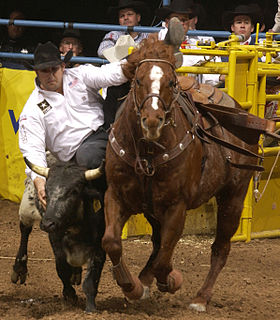 W
WA breastplate is a piece of riding equipment used on horses. Its purpose is to keep the saddle or harness from sliding back.
 W
WBreeching ( "britching") is a strap around the haunches of a draft, pack or riding animal. Both under saddle and in harness, breeching engages when an animal slows down or travels downhill and is used to brake or stabilize a load.
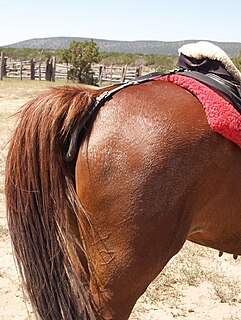 W
WA crupper is a piece of tack used on horses and other equids to keep a saddle, harness or other equipment from sliding forward.
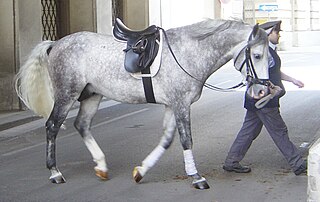 W
WEnglish saddles are used to ride horses in English riding disciplines throughout the world. The discipline is not limited to England, the United Kingdom in general or other English-speaking countries. This style of saddle is used in all of the Olympic and International Federation for Equestrian Sports (FEI) equestrian disciplines, except for the newly approved FEI events of equestrian vaulting and reining. Most designs were specifically developed to allow the horse freedom of movement, whether jumping, running, or moving quickly across rugged, broken country with fences. Unlike the western saddle or Australian Stock Saddle, there is no horn or other design elements that stick out above the main tree of the saddle.
 W
WA girth, sometimes called a cinch, is a piece of equipment used to keep the saddle in place on a horse or other animal. It passes under the barrel of the equine, usually attached to the saddle on both sides by two or three leather straps called billets. Girths are used on Australian and English saddles, while western saddles and many pack saddles have a cinch, which is fastened to the saddle by a single wide leather strap on each side, called a latigo.
 W
WKura (鞍), is the generic name for the Japanese saddle. The word "kura" is most commonly associated with the saddle used by the samurai class of feudal Japan. Over time the Japanese added elements of their own until the Japanese saddle became an identifiable style, also known as the samurai saddle.
 W
WThe McClellan saddle was a riding saddle designed by George B. McClellan, a career Army officer in the U.S. Army, after his tour of Europe as the member of a military commission charged with studying the latest developments in engineer and cavalry forces including field equipment. Based on his observations, McClellan proposed a design that was adopted by the Army in 1859. The McClellan saddle was a success and continued in use in various forms until the US Army's last horse cavalry and horse artillery was dismounted late in World War II. Today, the McClellan saddle is used by ceremonial mounted units in the US Army. The saddle was used by several other nations, including Rhodesia and Mexico, and to a degree by the British in the Boer War. The saddle came in various seat sizes that predominantly ranged from approximately 11 to 12 ½ inches.
 W
WA pack saddle is any device designed to be secured on the back of a horse, mule, or other working animal so it can carry heavy loads such as luggage, firewood, small cannons or other weapons too heavy to be carried by humans.
 W
WA pannier is a basket, bag, box, or similar container, carried in pairs either slung over the back of a beast of burden, or attached to the sides of a bicycle or motorcycle. The term derives from a Middle English borrowing of the Old French panier, meaning 'bread basket'.
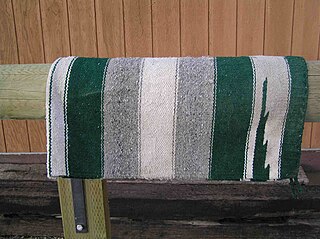 W
WThe terms saddle blanket, saddle pad, and saddle cloth refer to blankets, pads or fabrics inserted under a saddle. These are usually used to absorb sweat, cushion the saddle, and protect the horse's back. There are lighter types of saddle cloth, such as the shabrack, used primarily for decorative purposes, often placed over the top of a more utilitarian pad.
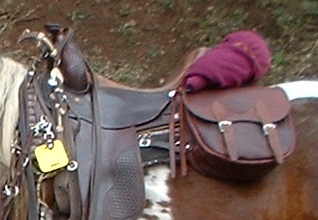 W
WSaddlebags are bags that are attached to saddles.
 W
WA shabrack or shabraque is a saddlecloth, formerly used by European light cavalry.
 W
WSidesaddle riding is a form of equestrianism that uses a type of saddle which allows a rider to sit aside rather than astride an equine. Sitting aside dates back to antiquity and developed in European countries in the Middle Ages as a way for women in skirts to ride a horse in a modest fashion while also wearing fine clothing. It has retained a specialty niche even in the modern world.
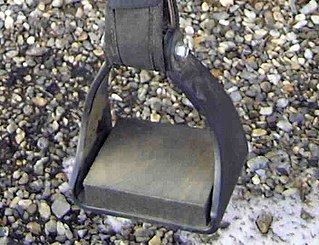 W
WA stirrup is a light frame or ring that holds the foot of a rider, attached to the saddle by a strap, often called a stirrup leather. Stirrups are usually paired and are used to aid in mounting and as a support while using a riding animal. They greatly increase the rider's ability to stay in the saddle and control the mount, increasing the animal's usefulness to humans in areas such as communication, transportation and warfare.
 W
WA surcingle is a strap made of leather or leather-like synthetic materials such as nylon or neoprene, sometimes with elastic, that fastens around the horse's girth.
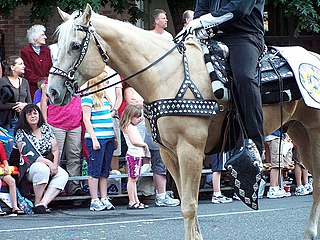 W
WA tapadero, sometimes referred to as a "hooded stirrup," is leather cover over the front of a stirrup on a saddle that closes each stirrup from the front. A tapadero prevents the rider's boot from slipping through and also prevents brush encountered while working cattle on the open range from poking through the stirrup, injuring or impeding the horse or rider. Some designs can also provide protection in cold weather. They are also frequently used with young riders, as many parents and riding instructors feel they are a safety precaution. Most commonly seen today on a western saddle, particularly certain types of children's saddles and parade horse saddles, the tapadero is not common in modern times and is not allowed in most show competition other than Parade Horse competition and children's leadline.
 W
WWestern saddles are used for western riding and are the saddles used on working horses on cattle ranches throughout the United States, particularly in the west. They are the "cowboy" saddles familiar to movie viewers, rodeo fans, and those who have gone on trail rides at guest ranches. This saddle was designed to provide security and comfort to the rider when spending long hours on a horse, traveling over rugged terrain.